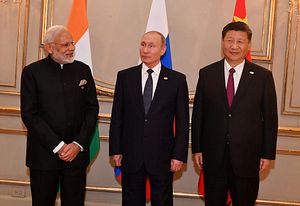On Friday, on the sidelines of the summit of the Group of 20 (G-20) summit in Buenos Aires, Argentina, the leaders of Russia, India, and China convened for the first leaders-level summit between their three countries in 12 years.
Russian President Vladimir Putin, Indian Prime Minister Narendra Modi, and Chinese President Xi Jinping met to discuss a range of regional and global issues. The trilateral has met at the level of foreign ministers in recent years, but the leaders of the three countries have met most intimately within the context of the BRICS summit, which also includes fellow large emerging economies Brazil and South Africa.
“The three leaders exchanged views on expanding mutual cooperation in international forums, and to encourage greater interaction among the three countries,” a statement released by the Indian Ministry of External Affairs noted.
“They agreed on the importance of reform and strengthening of multilateral institutions which have benefitted the world, including the United Nations, WTO and well-established as well as new global financial institutions,” the Indian statement added.
A Chinese state media report noted that Xi called on the three countries to “advocate a new type of international relations, keep consolidating political mutual trust, establish partnerships instead of alliances, and strive for a virtuous cycle in major-country relations and win-win cooperation.”
India’s statement acknowledged the need to strengthen other forums where the three countries participate, including the BRICS — which also had a meeting on the G-20 sidelines — the Shanghai Cooperation Organization, and the East Asia Summit.
For New Delhi, Modi’s participation in the RIC trilateral leaders’ summit may have appeared to serve as a form of balance given that this year’s G-20 also saw the convening of the first-ever trilateral leaders’ meeting between India, Japan, and the United States.
Modi joined Prime Minister Shinzo Abe of Japan and U.S. President Donald J. Trump to discuss global issues and the three countries’ common interest in a “free and open” Indo-Pacific. While India has historically practiced nonalignment, New Delhi has more overtly aligned itself with Asian democracies and the United States in recent years.
At the same time, China and Russia have converged strategically. Beijing sent a contingent of People’s Liberation Army troops to participate in Russia’s Vostok 2018 military exercises earlier this year, which were the largest exercises of their kind since the end of the Cold War.
India’s relationships with China and Russia are divergent too. Beijing and New Delhi compete and cooperate on a range of issues and have a significant trading relationship balanced in China’s favor; the two countries have two major active border disputes and entered a serious military standoff last year.
Russia, meanwhile, has an important defense relationship with India, which has purchased billions in Russian military equipment. Most recently, New Delhi purchased the S-400 surface-to-air missile system from Moscow, raising the possibility of triggering U.S. sanctions.
































